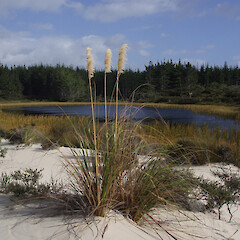Austroderia splendens
Common name
toetoe
Synonyms
Cortaderia splendens Connor
Family
Poaceae
Flora category
Vascular – Native
Endemic taxon
Yes
Endemic genus
Yes
Endemic family
No
Structural class
Grasses
NVS code
The National Vegetation Survey (NVS) Databank is a physical archive and electronic databank containing records of over 94,000 vegetation survey plots - including data from over 19,000 permanent plots. NVS maintains a standard set of species code abbreviations that correspond to standard scientific plant names from the Ngä Tipu o Aotearoa - New Zealand Plants database.
AUSSPL
Chromosome number
2n = 90
Current conservation status
The conservation status of all known New Zealand vascular plant taxa at the rank of species and below were reassessed in 2017 using the New Zealand Threat Classification System (NZTCS) – more information about this can be found on the NZTCS website. This report includes a statistical summary and brief notes on changes since 2012 and replaces all previous NZTCS lists for vascular plants.
Please note, threat classifications are often suggested by authors when publications fall between NZTCS assessment periods – an interim threat classification status has not been assessed by the NZTCS panel.
- Conservation status of New Zealand indigenous vascular plants, 2017 . 2018. Peter J. de Lange, Jeremy R. Rolfe, John W. Barkla, Shannel P. Courtney, Paul D. Champion, Leon R. Perrie, Sarah M. Beadel, Kerry A. Ford, Ilse Breitwieser, Ines Schönberger, Rowan Hindmarsh-Walls, Peter B. Heenan and Kate Ladley. Department of Conservation. Source: NZTCS and licensed by DOC for reuse under the Creative Commons Attribution 4.0 International licence.
2017 | Not Threatened
Previous conservation statuses
2012 | Not Threatened
2009 | Not Threatened
2004 | Not Threatened
Distribution
Endemic. A northern species common from the Three Kings Islands south to about Waikawau in the west and Ohiwa Harbour in the east—exact southern limit unclear.
Habitat
Abundant in coastal situations, within dunefield, associated shrublands, on cliff faces and on offshore islands.
Wetland plant indicator status rating
Information derived from the revised national wetland plant list prepared to assist councils in delineating and monitoring wetlands (Clarkson et al., 2021 Manaaki Whenua – Landcare Research Contract Report LC3975 for Hawke’s Bay Regional Council). The national plant list categorises plants by the extent to which they are found in wetlands and not ‘drylands’. The indicator status ratings are OBL (obligate wetland), FACW (facultative wetland), FAC (facultative), FACU (facultative upland), and UPL (obligate upland). If you have suggestions for the Wetland Indicator Status Rating, please contact: [Enable JavaScript to view protected content]
FAC: Facultative
Commonly occurs as either a hydrophyte or non-hydrophyte (non-wetlands).
Detailed description
Generally a robust, stout, rhizomatous tussock forming grass up to 6 m tall when in flower. Leaf-sheath clothed in long hairs, pale green, copiously covered in white wax. Ligule 3 (or more) mm long, contra-ligule (line of hairs at the leaf blade/culm junction) present. Leaf-blade 2–3(–4.8) × 0.3–0.5 m, yellow-green, green to dark-green, upper side glabrous, underside basally with dense weft of hairs, this becoming sparse toward midribs, trending toward mintuely hairy throughout. Culm up to 6 m, inflorescence portion up to 1 m tall, erect to nodding, plumose. Spikelets numerous, 40 mm with 2–3 florets per spikelet. Glumes equal, 40 mm with awn-like apex, > florets. Lemma 11 mm, 3-nerved, scabrid. Palea 9 mm, keels ciliate. Callus hairs 4 mm. Rachilla 1 mm. Flowers either perfect or female. Anthers of perfect flowers 6 mm, in females 4 mm. Ovary of perfect flowers 0.7 mm, stigma-styles 2 mm; female flowers with ovary 1 mm, stigma-style 4 mm. Seed 4–5 mm.
Manaaki Whenua Online Interactive Key
Similar taxa
This species can be distingushed from the other native Austroderia species best by the leaf blade, which is densely hairy above the ligule, and by the 3 mm (or more) long ligule, and presence of a contra-ligule. For distinctions from the naturalised Cortaderia see notes under Austroderia toetoe.
Flowering
September–November
Fruiting
October–March
Life cycle
Florets are wind dispersed (Thorsen et al., 2009).
Propagation technique
Easily grown from fresh seed (as a revegation exercise ripe seed heads can be pinned to soil surface, and if kept damp, soon germinate) and division of established plants.
Threats
Abundant and not threatened. Often naturalising in suitable habitats.
Etymology
splendens: Splendid
Where To Buy
Uncommon in cultivation. Occasionally offered by specialist native plant nurseries.
Cultural Use/Importance
Two ecotypes exist, a small form typical of coastal cliff faces and rocky islets, and a robust form confined to active and semi-consolidated dune field. The robust form, from which the type specimen was selected, is rhizomatous, and produces very large (2–3(–6) m) culms which push through sand, and so in cultivation can be recognised because the culms soon flop and fall over without support. The small ecotype (which some consider as a distinct, as yet undescribed species) is not rhizomatous, and has a more compact growth form, otherwise in leaf, ligule, flower, and seed characters it matches the robust form.
Attribution
Fact sheet prepared for NZPCN by P.J. de Lange 1 October 2006. Description adapted from Edgar & Connor (2000).
References and further reading
Edgar E, Connor HE. 2000. Flora of New Zealand. Vol. V. Grasses. Christchurch, Manaaki Whenua Press. 650 p.
Thorsen MJ, Dickinson KJM, Seddon PJ. 2009. Seed dispersal systems in the New Zealand flora. Perspectives in Plant Ecology, Evolution and Systematics 11: 285–309.
NZPCN Fact Sheet citation
Please cite as: de Lange, P.J. (Year at time of access): Austroderia splendens Fact Sheet (content continuously updated). New Zealand Plant Conservation Network. https://www.nzpcn.org.nz/flora/species/austroderia-splendens/ (Date website was queried)





